AMD Unveils Ryzen Threadripper 7000 Family: 96 Core Zen 4 for Workstations and HEDT
by Gavin Bonshor on October 19, 2023 9:00 AM EST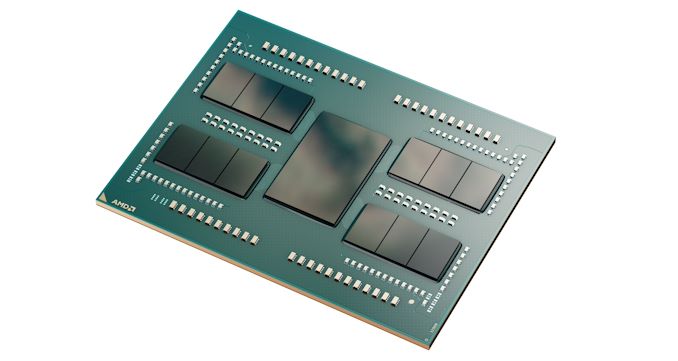
Having just recently crossed the one-year anniversary of AMD’s first Zen 4 architecture CPUs – the Ryzen 7000 series – we’re now at the point where the final Zen 4 products are landing in place. Thus far AMD has launched consumer desktop CPUs, multiple classes of mobile CPUs, and a bevy of server CPUs big (Genoa) and small (Siena). The one remaining gap in AMD’s product roadmap has been the workstation and high-end desktop market, which AMD will be filling next month with the launch of a pair of Threadripper product lineups.
Being announced today by AMD for a November 21st launch, this morning AMD is taking the wraps off of their Ryzen 7000 Threadripper CPUs. These high-end chips are being split up into two product lines, with AMD assembling the workstation-focused Ryzen Threadripper 7000 Pro series, as well as the non-pro Ryzen Threadripper 7000 series for the more consumer-ish high-end desktop (HEDT) market. Both chip lines are based on AMD’s tried and true Zen 4 architecture – derivatives of AMD’s EPYC server processors – incorporating AMD’s Zen 4 chiplets and a discrete I/O dies. As with previous generations of Threadripper parts, we’re essentially looking at the desktop version of AMD’s EPYC hardware.
With both product lines, AMD is targeting customer bases that need CPUs more powerful than a desktop Ryzen processor, but not as exotic (or expensive) as AMD’s server wares. This means chips with lots and lots of CPU cores – up to 96 in the case of the Threadripper 7000 Pro series – as well as support for a good deal more I/O and memory. The amount varies with the specific chip lineup, but both leave Ryzen 7000 and its 16 cores and 24 PCIe lanes in the dust.
Most notably for this generation of Threadripper parts, AMD is once again offering the HEDT-focused non-pro lineup. With the Zen 3-based Threadripper 5000 series, AMD only ever released the workstation-focused Pro parts, leaving HEDT hopefuls in the dust. But this time AMD has decided to bring the HEDT back, creating a pair of Threadripper lines in a very similar fashion to the Threadripper 3000 family in 2019.
Ryzen vs. Threadripper vs. Threadripper Pro
Based on AMD’s EPYC Genoa hardware, AMD is offering two classes of Threadripper products for the market, which are roughly split up in to workstation (Pro) and HEDT (non-pro) parts. Though truth be told, this is largely a matter of technical product segmentation rather than either version of Threadripper being unsuitable for a task. AMD is reserving more features – more cores, more I/O, and more bandwidth – for the Pro parts, while offering a further cut-down version of the hardware for the non-pro Threadripper 7000 series. This is nothing new for AMD, as they followed the same playbook for the Threadripper 3000 series as well, but it’s helpful to note that, despite being classified as a workstation product, Threadripper 7000 Pro is the more powerful part all-around.
All versions of the Threadripper 7000 family are based on AMD’s EPYC hardware, offering it in a configuration more suitable for desktop use. This means that these parts are using the same Zen 4 CCDs that we’ve come to love in the last year, as well as AMD’s beefy IOD for server use. Both processor lines will use the same socket, the 4844-pin LGA sTR5, which is being introduced with this generation of products. Though even with this shared socket, AMD is offering two motherboard platforms, WRX90 and TRX50, to back the new chips. We’ll get into the motherboards later, but at a high level, WRX90 is to be paired with Threadripper 7000 Pro, while TRX50 is meant to go with Threadripper 7000 (non-pro).
| AMD Ryzen 7000 (Zen 4) CPU Comparison | ||||
| AnandTech | Ryzen | Threadripper | Threadripper Pro | EPYC (Genoa) |
| Cores | 6-16 | 24-64 | 12-96 | 16-96 |
| Architecture | Zen 4 | Zen 4 | Zen 4 | Zen 4 |
| 1P Flagship | R9 7950X | TR 7980X | TR Pro 7995WX | EPYC 9654P |
| MSRP | $550 | $4999 | TBD | $10,625 |
| TDP | 170 W | 350 W | 350 W | 360 W |
| Base Freq | 4500 MHz | 2500 MHz | 2500 MHz | 2400 MHz |
| Turbo Freq | 5700 MHz | 5100 MHz | 5100 MHz | 3700 MHz |
| Socket | AM5 | sTR5 | sTR5 | SP5 |
| L3 Cache | 64 MB | 256 MB | 384 MB | 384 MB |
| DRAM Channels | 2 x DDR5-5200 | 4 x DDR5-5200 | 8 x DDR5-5200 | 12 x DDR5-4800 |
| DRAM Capacity | 192 GB (UDIMM) |
1TB, ECC (RDIMM) |
2 TB, ECC (RDIMM) |
6 TB, ECC (RDIMM) |
| PCIe | 5.0 x24 + chipset (x4) |
5.0 x48 + 4.0 x32 + chipset (x4) | 5.0 x128 + 4.0 x8 + chipset (x4) | 5.0 x128 |
| Pro Features | No | No | Yes | Yes |
With regards to features and specifications, the Threadripper 7000 Pro brings most of the EPYC experience to desktop hardware. AMD is offering chip SKUs with up to 96 Zen 4 CPU cores, as much as the best Genoa chip. Similarly, all Threadripper Pro parts come with an EPYC 128 lanes of PCIe 5.0 connectivity (plus some PCie 3.0 “bonus lanes). The biggest difference between Threadripper 7000 Pro and Genoa is memory support: whereas Genoa supports 12 lanes of DDR5 memory, Threadripper 7000 Pro supports 8 lanes. Or, if you’re comparing things to desktop Ryzen, 4x as many lanes as AMD’s current desktop processors.
The non-pro Threadripper 7000 series, on the other hand, is a bit more limited. The largest SKU is just 64 Zen 4 cores using 4 CCDs. And compared to its Pro counterpart, I/O has been altered significantly; here there’s just 48 lanes of PCIe 5.0, and meanwhile another 32 CPU PCIe lanes are available, but only running at PCIe 4.0 speeds. Altogether, this adds up to 80 PCIe lanes of various speeds. to just 48 lanes of PCIe 5.0. Meanwhile, there are half as many memory channels as with the Pro, giving the HEDT-focused Threadripper 4 channels of DDR5.
In an interesting twist, both platforms are using DDR5 Registered DIMMs (RDIMMs) this time around – and only RDIMMs. Unbuffered DIMMs (UDIMMs) are not supported, as these are not pin-compatible with RDIMMs. As a result, AMD has stuck with the tried and true memory of their server platform, RDIMMs. Furthermore, only 1 DIMM per channel (DPC) is supported here, meaning a maximum or 8 or 4 DIMMs respectively, depending on the platform. The upside to all of this? All of the Threadripper 7000 CPUs officially support speeds up to DDR5-5200, a step above the DDR5-4800 limit of AMD’s EPYC chips. And this doesn’t get in to overclocking, which is being made available for all Threadrippers.
AMD Ryzen Threadripper 7000 Pro WX-Series: What's New?
Navigating through AMD's Ryzen Threadripper 7000 Pro WX-series announcements, it's clear that the Ryzen Threadripper Pro 7000 series embodies their commitment to translating the scalability and core count of their 1P socketed EPYC capability into high-performance workstation computing. There are several integral implementations, and it's pivotal to understand the underlying architecture and features. With that perspective, we can genuinely appreciate the characteristics and thought processes behind AMD's latest workstation and HEDT offerings. Let's delve deeper into what this series brings to the table for the workstation segment.
The first of these is the upgrade over the Ryzen Threadripper 5000 Pro WX-series based on Zen 3, which has been upgraded to feature Zen 4 cores, and as such, comes with many performance benefits such as generational IPC performance improvements, as well as power efficiency and increased core clock speed capabilities.

Image of a selection of AMD Ryzen Threadripper 7000 Pro and one non-Pro series processors
Before we jump into the Ryzen Theadripper 7000 Pro WX series, it's worth noting that while they share some similarities to AMD's EPYC 9004 server portfolio, there are major differences to contend with. Threadripper and EPYC are integral parts of AMD's CPU portfolio and serve distinct sectors. Threadripper is primarily aligned with the HEDT and workstation sphere, optimized for content creation and 3D rendering applications. Essentially, AMD is bridging the gap between mainstream desktops and their expansive and scalable server CPUs. While EPYC is aimed at the enterprise and server market, Threadripper 7000 Pro and Threadripper 7000 serve as the middle ground between desktop and server, where users need higher core and thread counts for intensive workloads but do not necessarily require all the enhanced management capabilities.
More aligned with data-intensive workloads and virtualized environments, EPYC provides a higher core count via dual-socket support and enhanced security features that enterprise scenarios necessitate. It's tailored to ensure efficient data center operations, emphasizing more on scalability and ensuring that the performance is reliable and secure. In a nutshell, Threadripper targets power users and professionals on the desktop front, while EPYC answers many of the complex demands of server environments.
A closer look at a direct generational comparison between AMD's Ryzen Threadripper Pro 5000 WX-Series and 7000 Pro WX-Series shows an evolution of design and architecture. Going into some of the finer details, AMD provides a significant uplift in core counts and frequencies with the latest 7000 WX series. For instance, the family's flagship, the 7995WX, boasts an impressive 96 cores (192 threads), a leap of 50% compared to the 5995WX. Regarding base and boost clock frequencies, the 7995WX has a base core clock of 2.5 GHz with boost clocks of up to 5.1 GHz, showing an uptick of around 13% in clock speeds compared to the 5995WX at turbo frequencies.
Other generational improvements include up to 128 PCIe 5.0 lanes embedded within the IOD and more L3 cache available to the top SKU. The Ryzen Threadripper 7995WX Pro chip has 384 MB of L3 cache, split into 32 MB of L3 cache per CCD (12 in total). This is a 50% improvement in L3 cache amount compared to the previous generation Ryzen Threadripper 5995WX, primarily due to the larger number of CCDs.
| AMD Ryzen Threadripper 7000 Pro WX-Series (Zen 4) | |||||||||
| AnandTech | Cores | Base Freq |
Turbo Freq |
PCIe (Gen 5) |
CCDs + I/O |
Cache (L3) |
TDP | DRAM (RDIMM) |
Price ($) |
| 7995WX | 96 / 192 | 2500 | 5100 | 128 | 12 + 1 | 384 MB | 350W | 8 x DDR5-5200 | TBD |
| 7985WX | 64 / 128 | 3200 | 5100 | 128 | 8 + 1 | 256 MB | 350W | 8 x DDR5-5200 | TBD |
| 7975WX | 32 / 64 | 4000 | 5300 | 128 | 4 + 1 | 128 MB | 350W | 8 x DDR5-5200 | TBD |
| 7965WX | 24 / 48 | 4200 | 5300 | 128 | 4 + 1 | 128 MB | 350W | 8 x DDR5-5200 | TBD |
| 7955WX | 16 / 32 | 4500 | 5300 | 128 | 2 + 1 | 64 MB | 350W | 8 x DDR5-5200 | TBD |
| 7945WX | 12 / 24 | 4700 | 5300 | 128 | 2 + 1 | 48 MB | 350W | 8 x DDR5-5200 | TBD |
However, it's not all about the flagship, as even the mid-tier chips, such as the 7975WX, demonstrate marked improvements in core frequencies with a base core clock of 4.0 GHz and boost clocks of up to 5.3 GHz. Similarly, the entry-level chips, the 7955WX with 16C/32T and 7945WX with 12C/24T, also feature base clocks at 4.5 GHz and 4.7 GHz, respectively. Unfortunately, there is a caveat to having increased core counts and upticks in both base and boost frequencies, as all of the Ryzen Threadripper Pro 7000 WX-Series chips come with a large 350 Watt TDP; this is an increase of 25% over the 280 W TDP on the Ryzen Threadripper Pro 5000 WX-series chips.
AMD's Ryzen Threadripper 7000 Pro WX-series processors are designed to offer an alternative to Intel's latest workstation platform, the Intel Xeon W-3400 series, based on their Sapphire Rapids architecture. A couple of key highlights AMD is trying to promote between the competition is Threadripper 7000 Pro WX has 1.7x the core count when comparing the 7995X to Intel's Xeon W9-3495X, as well as faster boost clocks, as well as more than three times the amount of L3 cache available.
Another benefit of the Ryzen Threadripper 7000 Pro WX series over its predecessor is that the Zen 4 architecture used within the cores brings official support for the AVX-512 instruction set. Similar to the Ryzen 7000 series for desktops, the Zen 4 core allows AVX-512 intrinsics and execution through two 256-bit pathways. This is designed to provide clear performance benefits in workloads using the AVX-512 instruction set and improves INT8 inferencing as AMD's implementation of AVX-512 is done in 8-bit values. AMD's implementation of AVX-512 support essentially spreads the 512-bit instructions over two cycles fed into two 256-bit vector paths.
One of the more interesting elements of Threadripper 7000 Pro's design allows for 'thread pinning.' Because AMD is using using a chiplet-based design, AMD has developed the tools to override the default OS scheduling and to control which CCDs threads are loaded/pinned on to.
By doing so, AMD is looking to manipulate the location of threads to get the best performance for a workload – and to work-around the relatively high die-to-die latency penalties with their chiplet architecture. With up to 12 CCDs in play, there is a significant amount of L3 cache available that can help cache-constrained workloads; but some workloads are also significantly harmed by the cross-CCD latency. The end result is that for Threadripper, AMD is providing the tools to control where threads land.
Using the 7995WX as an example, which has 12 CCDs, AMD's thread pinning means that if a workload is using 12 threads, the optimizations through thread pinning can place each thread on a different CCD, which enables the workload to effectively use all 384MB of L3 cache. Conversely, some workloads may need to stick together on as few CCDs as possible, which is more traditional OS scheduling behavior.
The key takeaway is that AMD needs to be careful in how thread pinning is used, as the penalty incurred in latency must outweigh the benefits of using more L3 cache. There's a fine line between being able to encapsulate the benefits of L3 cache using threads across 8 or 12 CCDs, as not all workloads and instruction sets will benefit from L3 cache. It will be interesting to see how AMD is differentiating between the latency penalty to inhibit more L3 cache in specific workloads, where performance may be penalized for doing so.
One use case that benefits from having more L3 cache is in Anysys Fluent 2022 R1. We've reached out to AMD to qualify how thread pinning is enabled, whether or not this is a software application-specific optimization, or whether it requires a specific executable to be run in the background, which sets core affinity, etc. As we always say with in-house performance figures, take them lightly, but using thread pinning to enable more L3 cache throughput, an uptick of 12% is good.
Providing the much-needed improvement for the inception of the Ryzen Threadripper 7000 Pro WX-series is AMD's high-end IOD, which is another carryover from the EPYC lineup and is built using TSMC's N6 node. It offers ports to connect up to 12 CCDs, and compared to the IOD used in the Ryzen Threadripper 5000 Pro, offers an improved, lower-power die-to-die chiplet interface. AMD claims to have doubled the probe throughput while it offers up to 36 Gbps with a 20:1 clock ratio, which can reach a FCLK of up to 1.8 GHz.
Looking at an example using AMD's in-house performance figures, which should always be taken with a pinch of salt, shows some incredible performance uplifts in areas such as design and manufacturing. These include claims of up to 45% faster designing performance with the Ryzen Threadripper 7000 Pro 7975WX (32/64) using SolidWorks, with up to 44% rendering performance in Luxion Keyshot compared to Intel's Xeon W9-3475 flagship 56-core chip. That isn't factoring in any performance benefits when opting for AMD's top SKU, the 96C/192T 7995WX chip.

Test system at AMD HQ in Austin, TX, with the Ryzen Threadripper 7985WX 64C/128T CPU
During AMD's Threadripper 7000 Pro WX series tech day at HQ in Austin, we not only got a first glimpse at Theadripper 7000 Pro in the flesh, but also saw how they performed using air cooling and AIO cooling. While we can't talk about performance, AMD did show impressive gains in benchmarks such as CineBench R23 and 7-Zip, especially when overclocking using Precision Boost Overdrive (PBO). AMD also did a live LN2 overclocking demonstration with AMD's in-house 'overclocking team' of enthusiasts and engineers within the company instead of hiring an all-star extreme overclocking champion to do the work. We were impressed with what we saw, and Ryzen Threadripper 7000 Pro WX looks set to bring much higher performance on Zen 4 than we've seen so far with their Ryzen 7000 desktop processors.
AMD Ryzen Threadripper 7000: Bringing The HEDT Back
The other chips AMD is launching are the regular Ryzen Threadipper 7000 series, which, as mentioned, signals the first HEDT platform for consumers since 2019 with the Ryzen Threadripper 3000 series. Skipped for the Ryzen 5000/Zen 3 generation, AMD has signaled their intentions to bring HEDT back to the market. The progression of desktop processors to include higher core counts and performance brought parity to the main selling point of a designated HEDT platform over the last 10 years.
Achieving that core/thread parity level somewhat killed the demand for HEDT platforms, such as Intel's X299, which, through the Cascade Lake Intel Core i9-10980XE (18C/36T) Extreme processor. Given Intel's current flagship, the Core i9-14900K (24C/32T), and AMD's Ryzen 9 7950X (16C/32T) not only match or surpass older HEDT platforms, but the IPC gains through generational improvements make the desktop market more attractive. AMD's Threadripper 7000 series brings back the higher core counts and provides more bandwidth with four memory channels over desktop.
In applications and workloads that can benefit from this, users now have a more refined HEDT option, and AMD has updated what HEDT now is from what it was. It's also interesting that AMD no longer markets gaming as a feature on Threadripper 7000, as we've seen in previous generations. When AMD launched the Zen 2-based Ryzen Threadripper 3990X processor, they marketed it with a 'game mode,' which disabled half of the chip and was designed to ensure compatibility and more performance in games with unoptimized code. All that notion of gaming on HEDT seems to be no more, which doesn't mean users can't game on Threadripper 7000, but it's more that Ryzen 7000 is primarily targeted in this area.
Focusing on the top SKU, the Ryzen Threadripper 7980X, it features 64C/128T with the latest Zen 4 cores and boasts a turbo clock speed of up to 5.1 GHz, with a base core clock frequency of 2.5 GHz. Moving down the stack is the Threadripper 7980X, which has 32C/64T, a higher 3.2 GHz base frequency with the same 5.1 GHz turbo clock speeds. Offered up as the 'entry-level' SKU to the platform is the Threadropper 7960X, which has 24C/48T clocked at 3.2 GHz and has a slightly higher turbo core frequency of up to 5.3 GHz.
| AMD Ryzen Threadripper 7000 (Zen 4) | ||||||||
| AnandTech | Cores | Base Freq |
Turbo Freq |
PCIe (Gen 5) |
Cache (L3) |
TDP | DRAM (RDIMM) |
Price ($) |
| 7980X | 64 / 128 | 2500 | 5100 | 48 | 256 MB | 350W | 4 x DDR5-5200 | $4999 |
| 7970X | 32 / 64 | 3200 | 5100 | 48 | 128 MB | 350W | 4 x DDR5-5200 | $2499 |
| 7960X | 24 / 48 | 3200 | 5300 | 48 | 128 MB | 350W | 4 x DDR5-5200 | $1499 |
The key differential between the Threadripper 7000 Pro and the non-pro Threadripper 7000 comes in the form of I/O and memory limitations. While TR 7000 goes up to 64C/128T through the 7980X, the processor supports just four channels of memory and 80 PCIe lanes from the CPU, with 48 conforming to the latest PCIe 5.0 standard. The other apparent reason for the specific segmentation is that AMD creates a clear-cut difference between the more professionally geared Pro WX chips and the regular Threadripper 7000 SKUs, a segue into the HEDT market.
The Ryzen Threadripper 7000 series starts with the 7960X, a 24C/48T chip that represents a bump in core and thread count over the Ryzen 9 7950X 16C/32T processor for desktops on AM5. It's essentially offering more Zen 4 cores, more threads, more L3 cache, and quad channel memory support to consumers, without having to spend the additional money on professional features that won't be used or needed.
AMD WRX90 and TRX50 Platforms: Difference Between Workstations and HEDT
To complement the launch of the Ryzen Threadripper 7000 Pro WX and 7000 series are a pair of new but distinguishable motherboard platforms. This includes the WRX90 platform, designed for workstations, and the TRX50 platform, designed to offer designs more in line with HEDT capabilities and costs.
As noted earlier, both platforms use the same sTR5 socket, which uses 4844 pins. For those keeping track, this is the same number of pins as SP6, the socket AMD introduced for their lower-priced EPYC 8004 (Siena) processors. And as the Threadripper 7000 lineup is an EPYC derivative, the TRX50 and WRX90 motherboards are unsurprisingly using a derived socket. Though it goes without saying that sTR5 and SP6 are not pin compatible – though we understand that older socket sTRX4 Threadripper coolers will still fit on the 58.5mm x 75.4mm socket.
The higher spec of the two is WRX90, which is specifically designed for the Ryzen Threadripper 7000 Pro WX-series. WRX90 boards will support 8 channels of memory, for up to 1 TB of DDR5-5200 RDIMMs. Meanwhile, the TRX50 platform is primarily designed to be used with the non-pro Threadripper chips, with those boards supporting 4 channels of memory and just 48 CPU PCIe 5.0 lanes (plus 32 CPU PCIe 4.0 lanes).
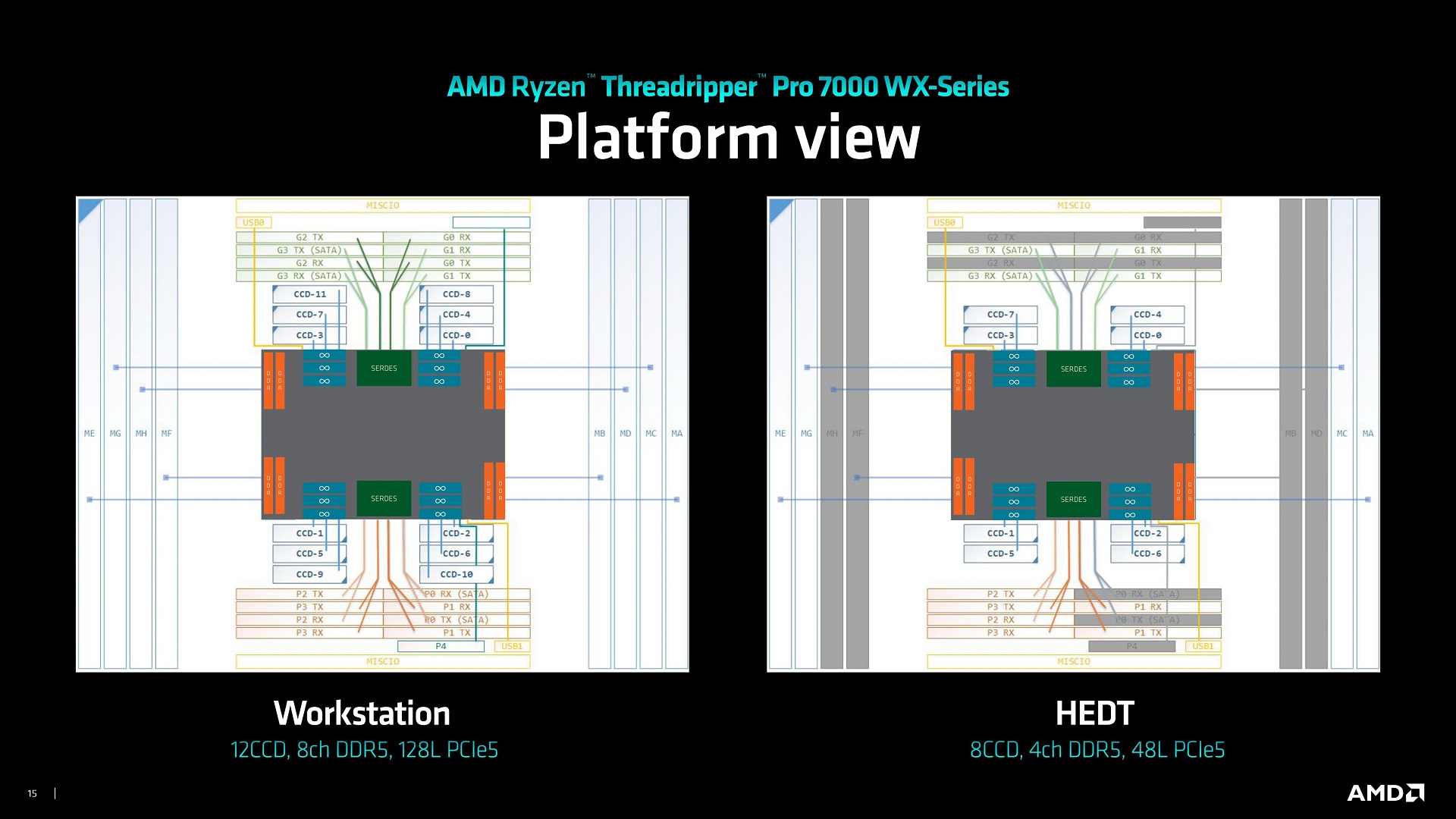
Platform diagram of the WRX90 (left) and TRX50 (right)
Dissecting the key differences between the two platforms, WRX90 is solely designed for the Threadripper Pro chips. The WRX90 platform, combined with the Pro chips, can utilize up to 128 PCIe 5.0 lanes, allowing users to take full advantage of the AMD Pro series features. That leaves TRX50 as the "budget" platform design. With fewer memory channels, boards should be cheaper to build. And similarly, motherboard vendors will have an easier time assembling boards with just 48 PCIe 5.0 lanes (and the remainder being PCIe 4.0), as PCIe Gen5 is more complex to implement and, on longer tracks between slots and devices, require re-drivers, which can add to the cost.
Interestingly, Threadripper 7000 Pro chips can also be used in TRX50 motherboards. But of course, they will be subjected to the same memory channel and I/O limitations. Essentially, TRX50 boards can be used as a budget board pairing for Threadripper Pro chips. Otherwise, the converse is not true: non-pro Threadripper 7000 chips cannot be used in WRX90 boards, as illogical as that would be.
Still, both platforms holistically support DDR5-5200 RDIMM memory, another generational shift as the previous Ryzen Threadripper 5000 Pro series supported DDR4 memory. WRX90 can support up to 2 TB of DDR5-5200 RDIMM, while the TRX50 platform is limited to 1 TB of DDR5-5200 RDIMM capacity.
Regarding availability, all the AMD Ryzen Threadripper 7000 Pro WX-series and Ryzen Threadripper 7000 SKUs are set to launch on November 21st at retailers. At the time of writing, only the Threadripper 7000 (non-Pro) pricing has been revealed, with the 7980X costing $4999, the 7970X at $2499, and the entry-level 7960X costing $1499. Relevant TRX50 and WRX90 motherboards to support the launch are expected to be announced soon, with availability also likely to be on November 21st.


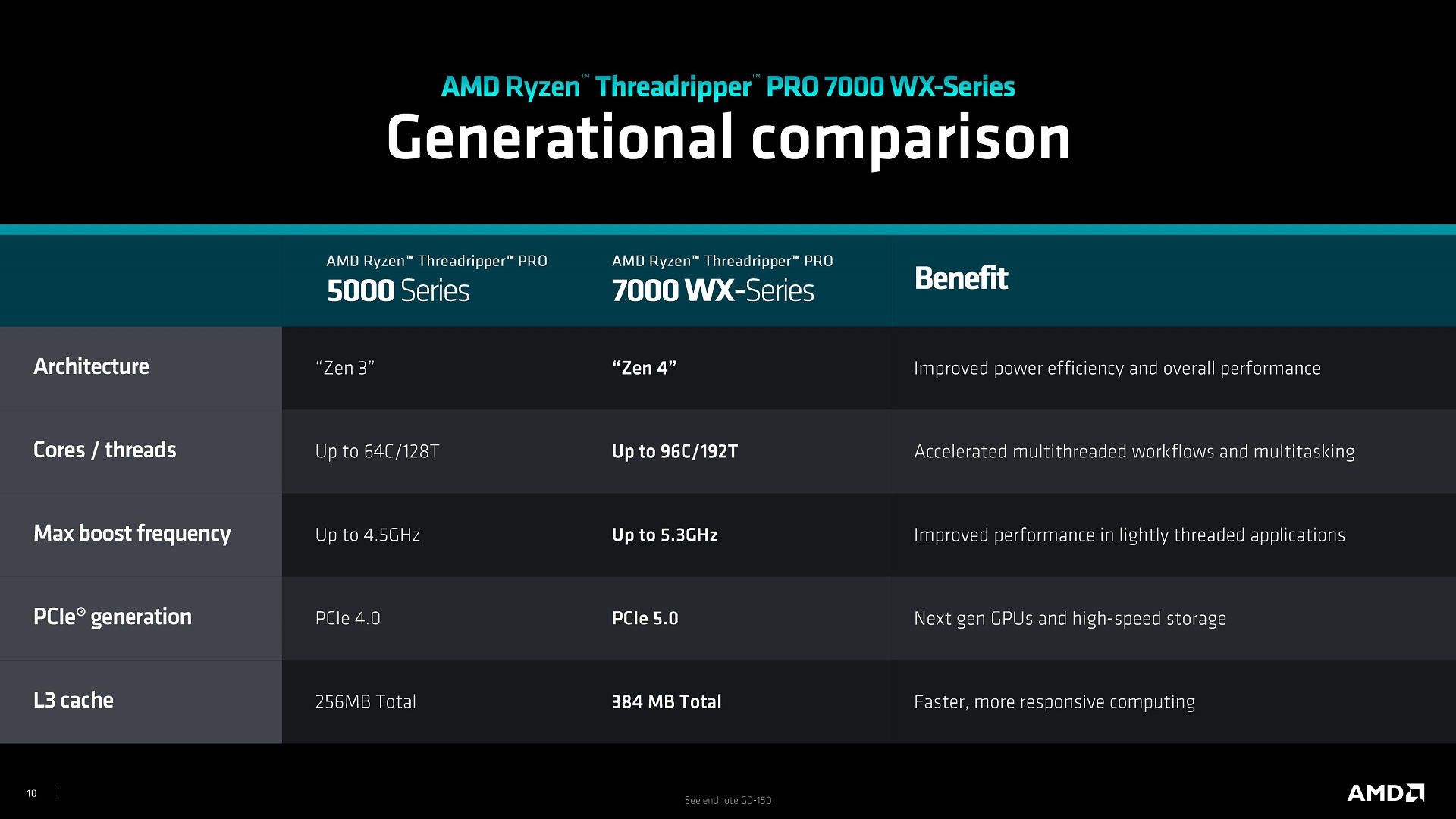

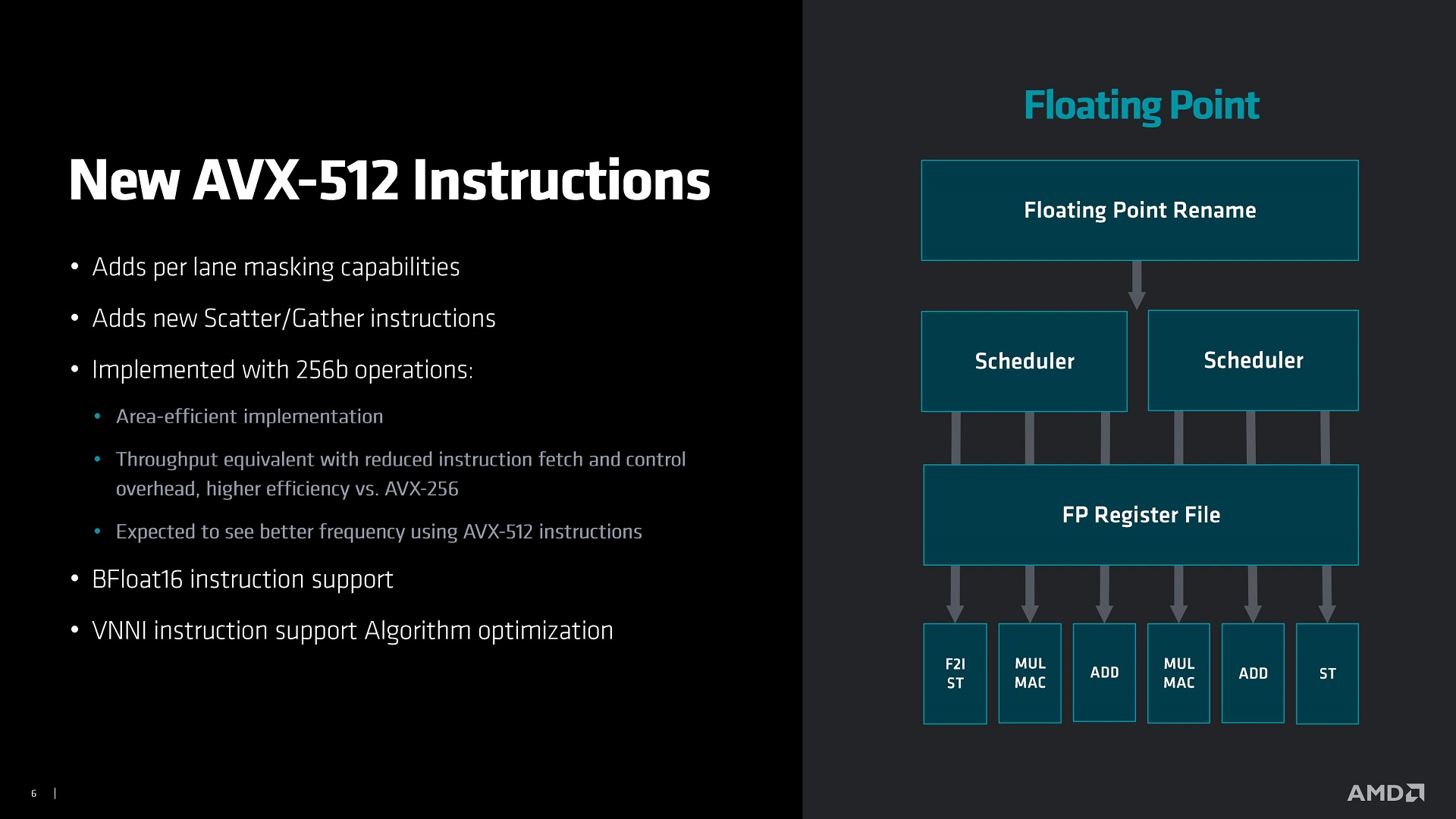
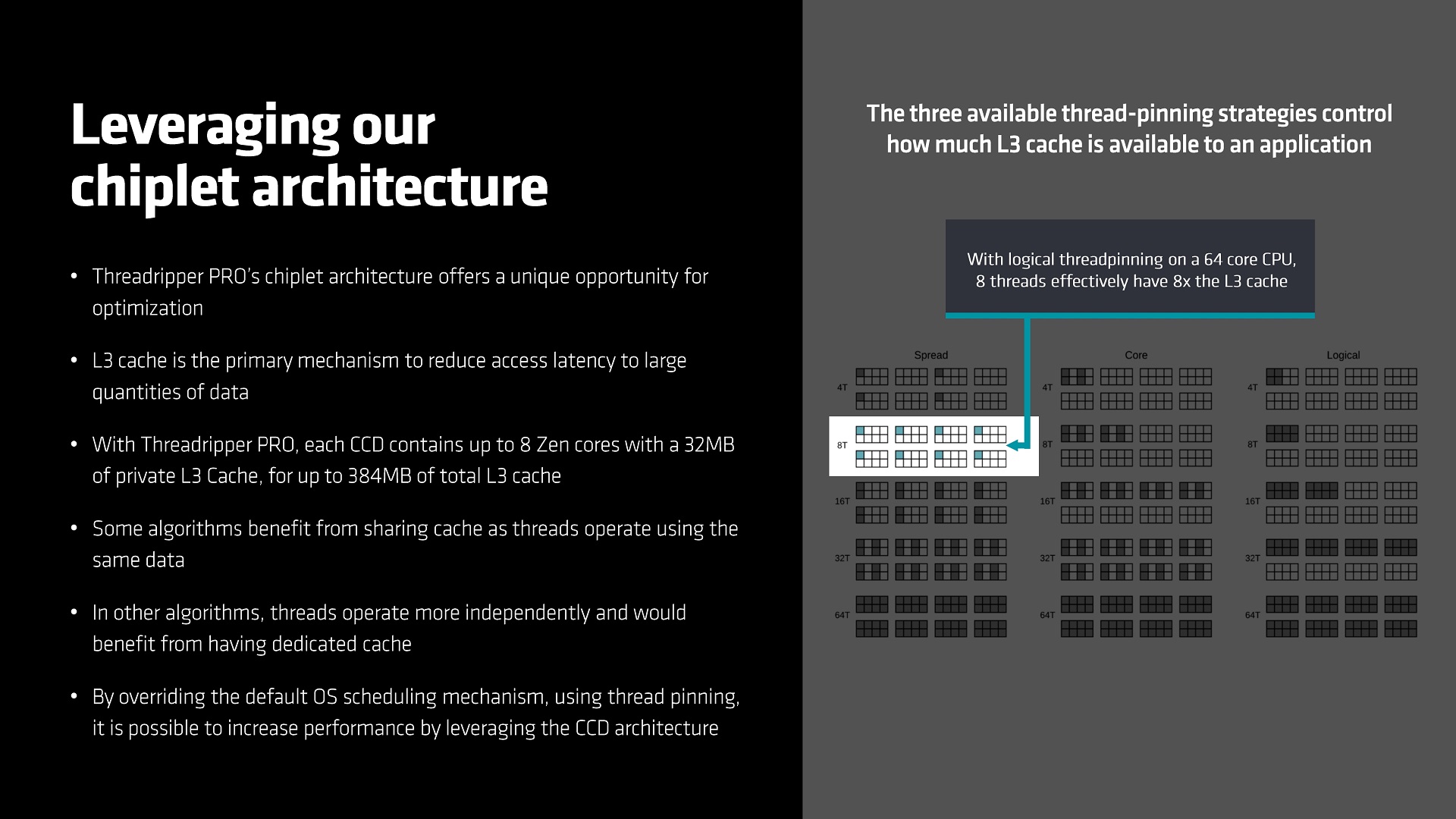
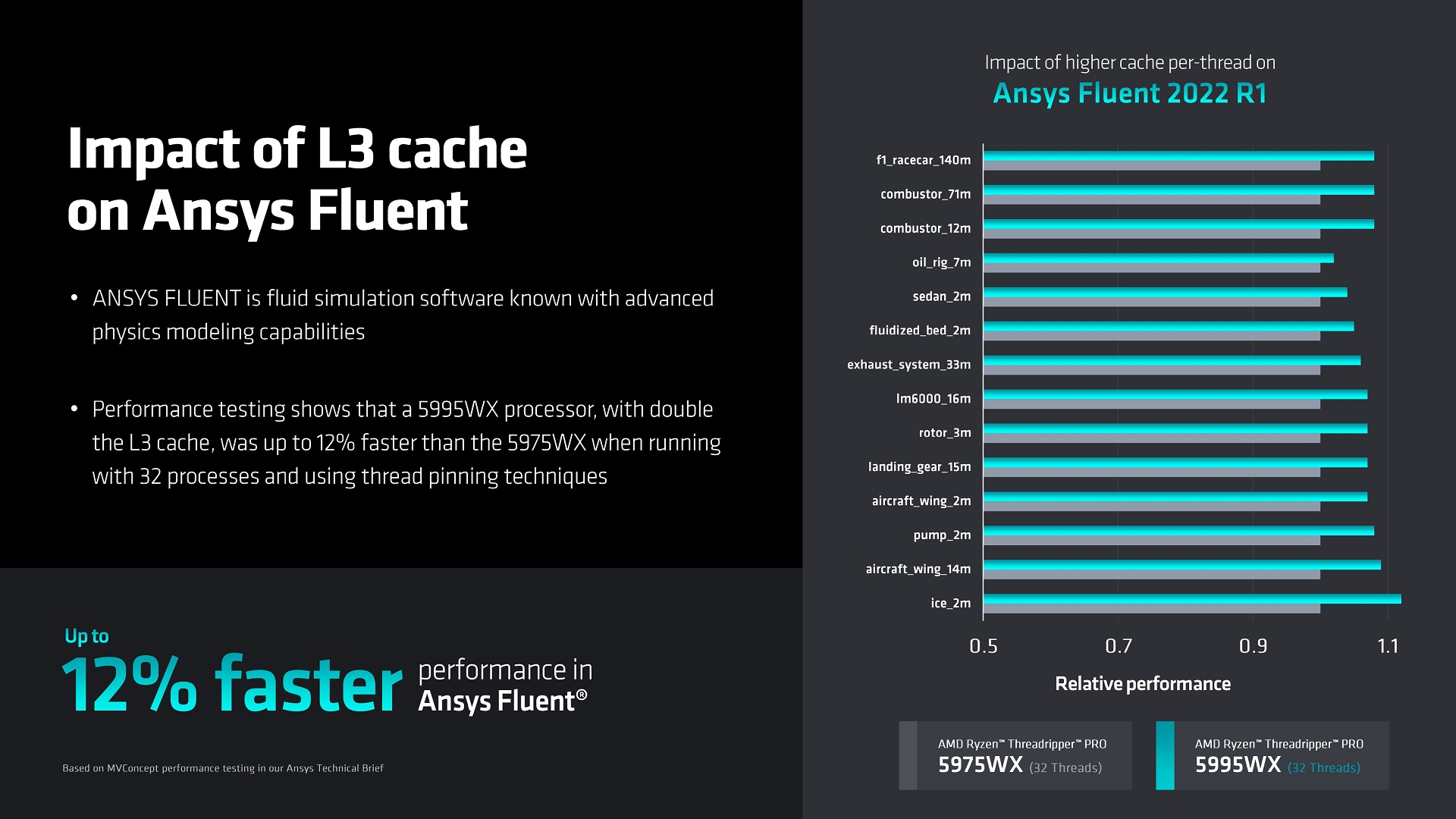
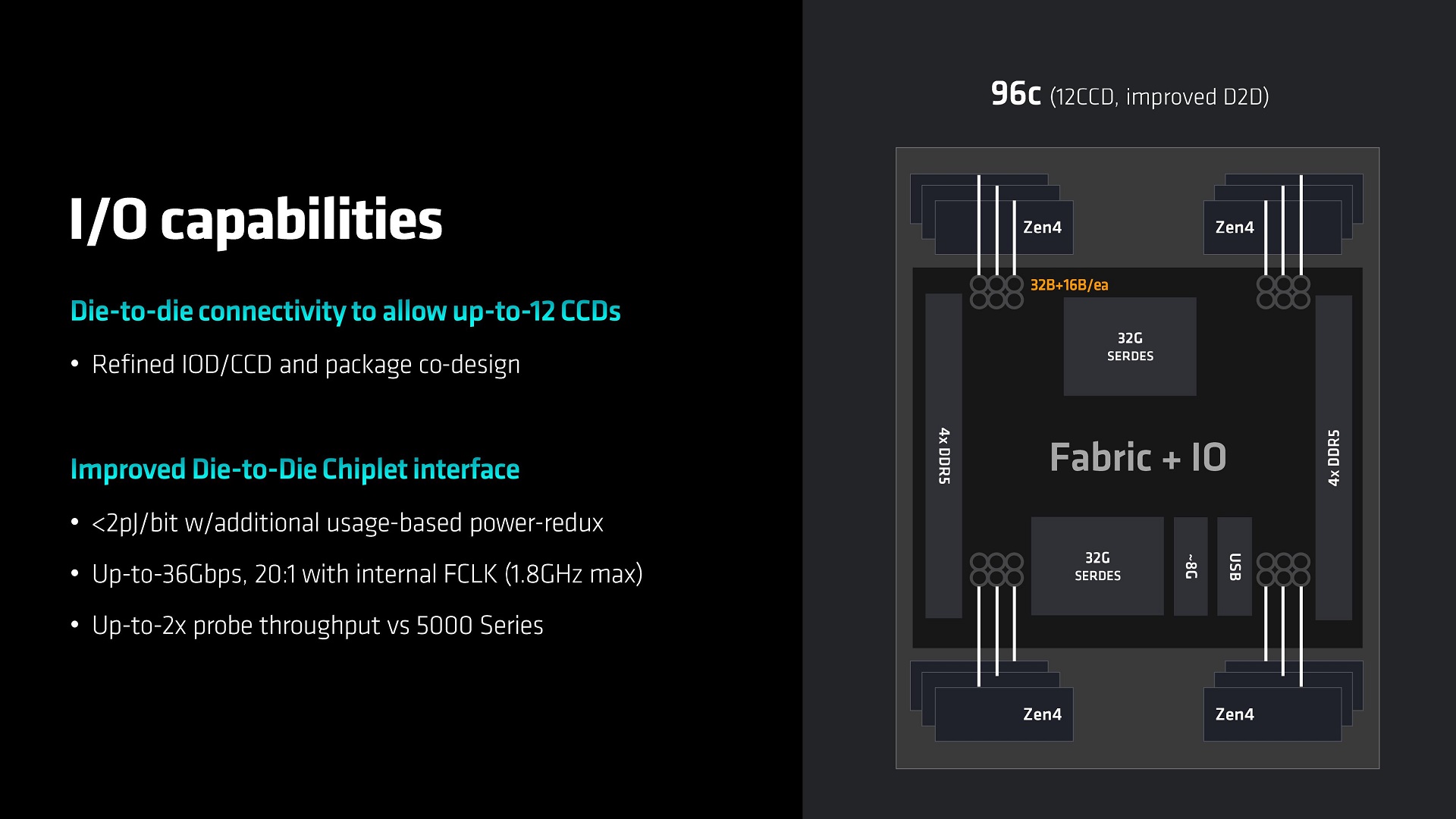
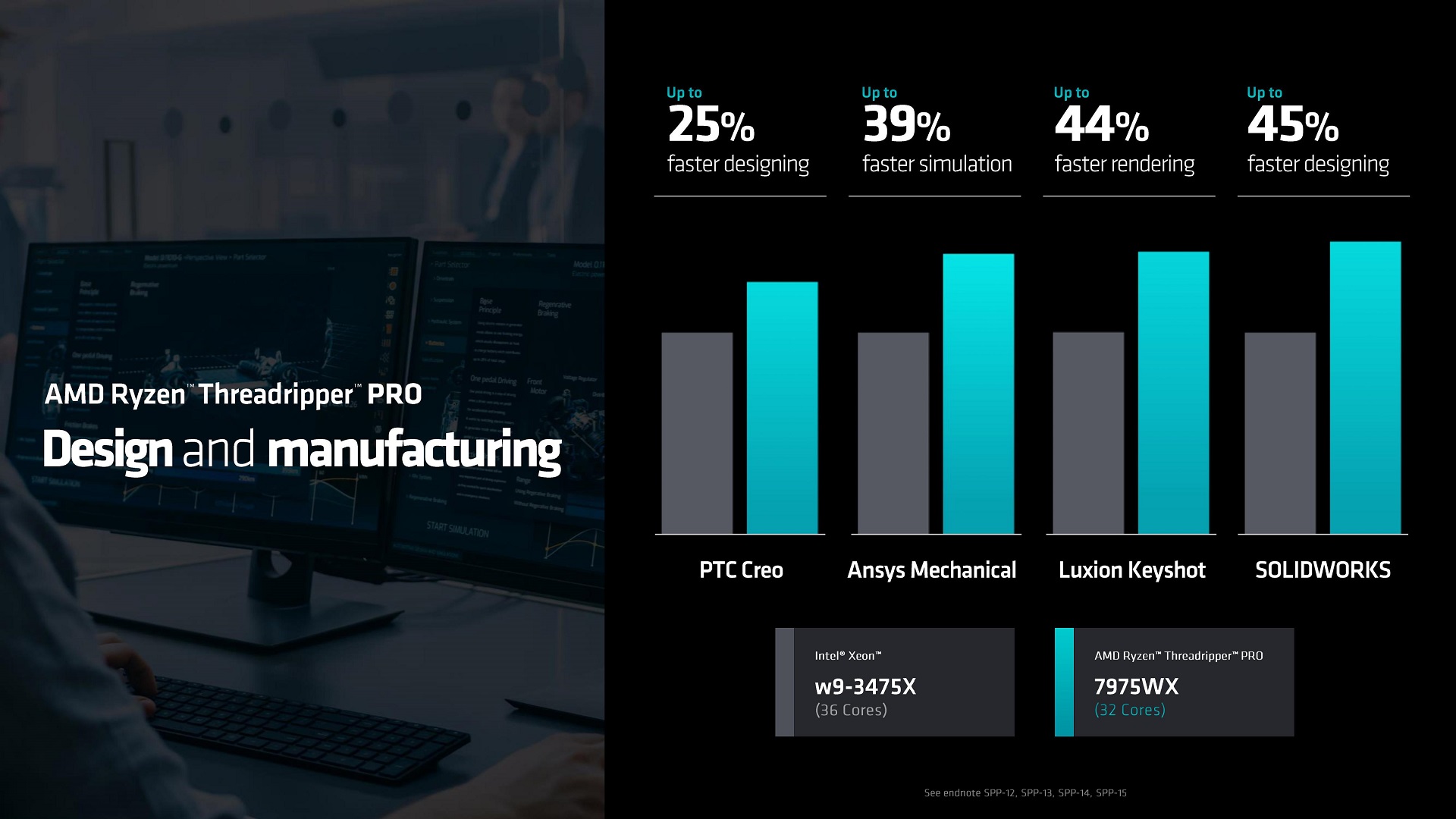
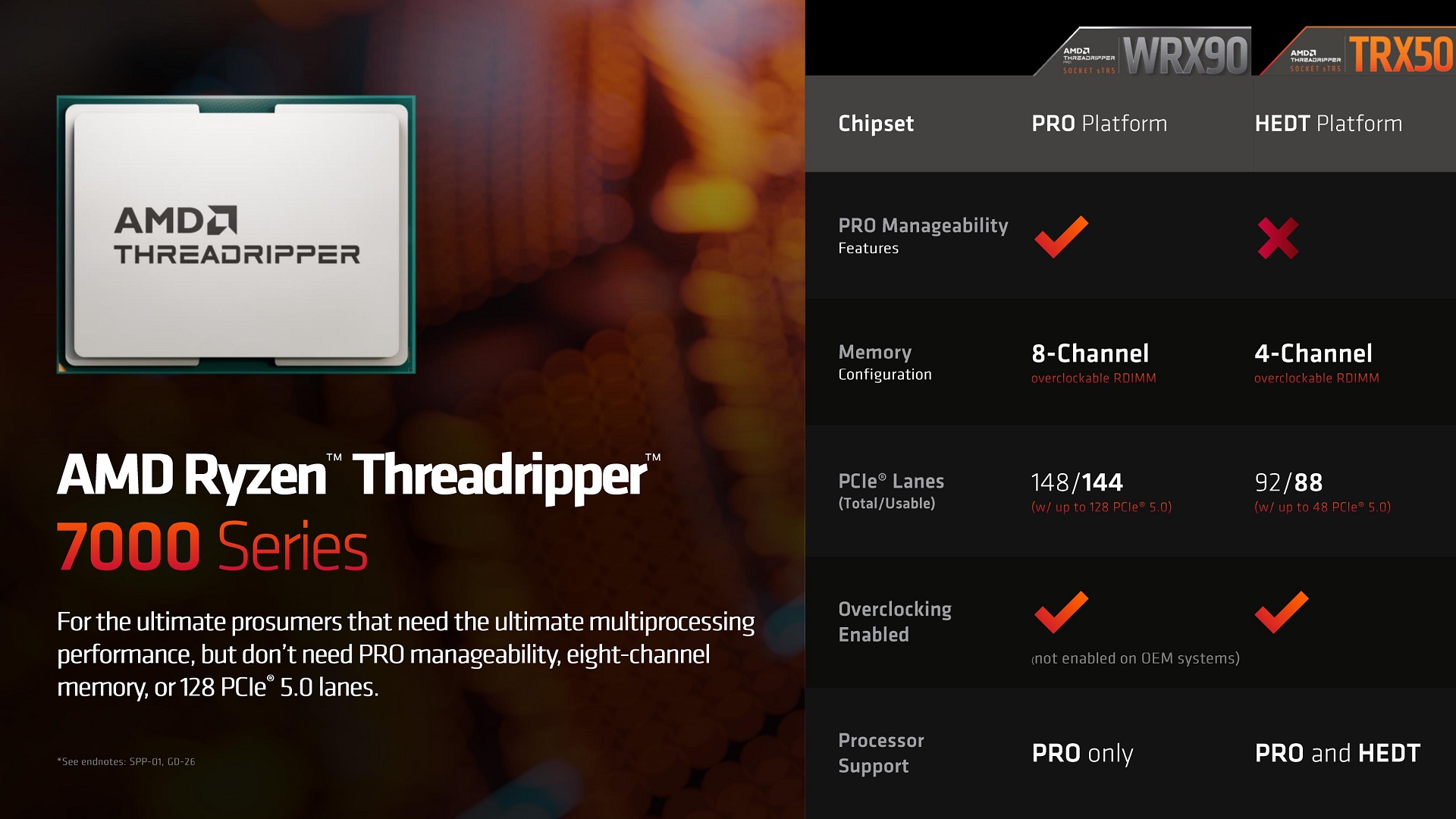
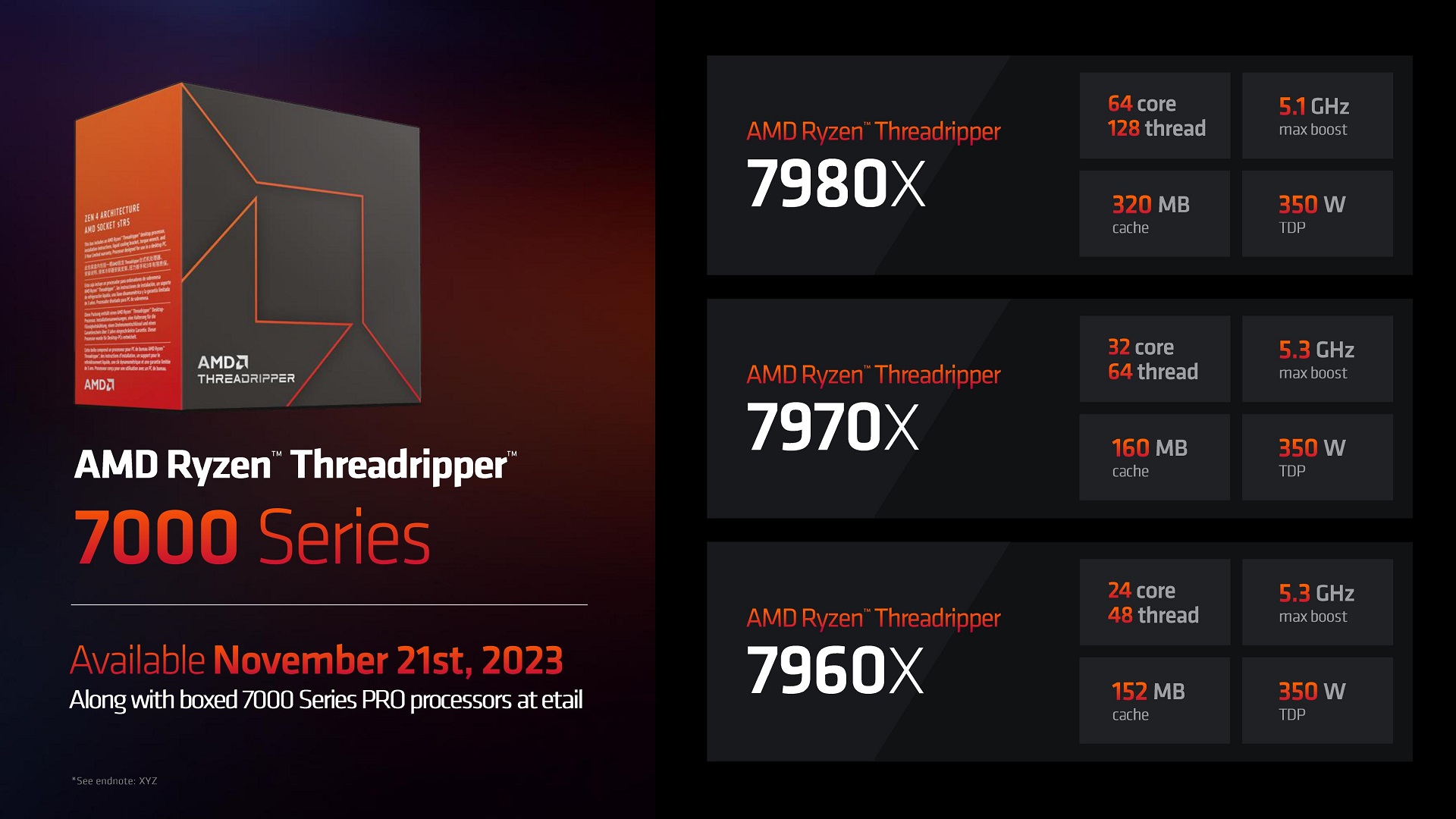
_thumb.jpg)
_thumb.jpg)
_thumb.jpg)
_thumb.jpg)
_thumb.jpg)
_thumb.jpg)








47 Comments
View All Comments
Makaveli - Thursday, October 19, 2023 - link
This was a great write up lots of info thank you.colonelclaw - Thursday, October 19, 2023 - link
Typo in "AMD Ryzen Threadripper 7000 Pro WX-Series (Zen 4)" table. Base and Turbo frequencies the wrong way around on 5 of the SKUs.Ryan Smith - Thursday, October 19, 2023 - link
Fixed. Thanks!love2fly59 - Thursday, October 19, 2023 - link
The frequencies need to be swapped in the table: "AMD Ryzen Threadripper 7000 Pro WX-Series (Zen 4)" too.
I also noticed this mix up as well: "WRX90 boards will support 8 channel of memory, for up to 1 TB of DDR5-5200 RDIMMs"
meacupla - Thursday, October 19, 2023 - link
Intel's answer to this will be.... a 5000W CPU, my guess.duploxxx - Thursday, October 19, 2023 - link
intel answer to this is a dual socket motherboard just like in the Xeon series. For every 1p sales of AMD , Intel has to counter it with a 2P sales to come near in performance. The additional wasted power consumption, numa complexity, etc. is something they prefer not to mention....im.thatoneguy - Thursday, October 19, 2023 - link
Actually Intel had a very sensible answer to this announced 6 months ago.https://www.anandtech.com/show/18741/intel-launche...
schujj07 - Thursday, October 19, 2023 - link
That was an answer to the Zen 3 based Threadrippers. We know that the current SPR based Xeon's are only really able to compete with Epyc 7003 series when accelerators aren't used.CrystalCowboy - Thursday, October 19, 2023 - link
"There are quite a few integral implementations through gritty"This could use some work. I would offer a suggestion but I can't figure out what was intended.
Ryan Smith - Thursday, October 19, 2023 - link
Spell checkers (AI!) run amok. Thanks!